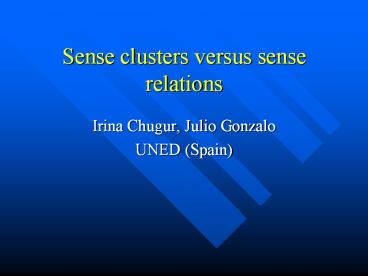Sense clusters versus sense relations - PowerPoint PPT Presentation
Title:
Sense clusters versus sense relations
Description:
subtle distinctions produce noise in applications. WN too fine-grained ... Bulbuos plant (kind of alliaceous plant) 2. Pungent bulb (kind of vegetable) 3. ... – PowerPoint PPT presentation
Number of Views:88
Avg rating:3.0/5.0
Title: Sense clusters versus sense relations
1
Sense clusters versus sense relations
- Irina Chugur, Julio Gonzalo
- UNED (Spain)
2
Sense clusters vs. Sense relations
- Arguments for sense clustering
- subtle distinctions produce noise in
applications - WN too fine-grained
- Remove predictable sense extensions?
3
Sense clusters vs. Sense relations
- Arguments for sense clustering
- subtle distinctions produce noise in
applications - WN too fine-grained
- Remove predictable sense extensions?
But... clusters are not absolute (e.g.
metaphors in IR/MT) not really! Use them to infer
and study systematic polysemy
Polysemy relations are more informative and
predictive WN rich sense distinctions permit
empirical /quantitative studies on polysemy
phenomena
4
Sense clusters vs. Sense relations
- Arguments for sense clustering
- subtle distinctions produce noise in
applications - WN too fine-grained
- Remove predictable sense extensions?
But... clusters are not absolute (e.g., are
metaphors close?) not really! Use them to infer
and study systematic polysemy
Polysemy relations are more informative and
predictive Annotation of semantic relations in
1000 wn nouns
5
Sense distinctions for IR
- Helpful distinctions
- Spring
- season
- Fountain
- Metal device
- To jump
- Bank
- River bank
- Seat
- Financial institution
- Useless distinctions
- Bet
- Act of gambling
- Money risked on a gamble
- To gamble
- Bother
- Smth. or someone who causes trouble, a source of
unhappiness - An angry disturbance
6
1) Cluster evidence from Semcor
- Hypothesis if two senses tend to co-occur in the
same documents, they are not good IR
discriminators. - Criterion cluster senses that co-occur
frequently in IR-Semcor collection. - Example fact 1 and fact 2 co-occur in 13 out of
171 docs. - Fact 1. (a piece of information about
circumstances that exist or events that have
occurred) - Fact 2. (a statement or assertion of verified
information about something that is the case or
has happened)
7
Cluster from Semcor results
- Positive clusters 507 (630 sense pairs)
- Threshold docs ? 2 with similar distribution of
senses - Precision 70 (directly related to threshold)
- Negative clusters 530
- Threshold sense occurrences ? 8
- Precision 80
8
2) Cluster evidence from parallel polysemy
9
2) Cluster evidence from parallel polysemy
French
German
Band 2
Groupe 9 Groupe 6
Band 2
10
Parallel polysemy in EuroWordNet
- English Spanish French
German - child,kid ? niño,crío,menor?enfant,mineur
? Kind - male child, ? niño ? enfant
? Kind,Spross - Boy,child
11
Comparison of clustering criteria
12
Clusters vs. semantic relations
Polysemy relations are more predictive!
13
Characterization of sense inventories for WSD
- Given two senses of a word,
- How are they related? (polysemy relations)
- How closely? (sense proximity)
- In what applications should be distinguished?
- Given an individual sense of a word
- Should it be split into subsenses? (sense
stability)
14
Cross-Linguistic evidence
Fine 40129 Mountains on the other side of the
valley rose from the mist like islands, and here
and there flecks of cloud as pale and
lttaggtfinelt/taggt as sea-spray, trailed across
their sombre, wooded slopes. TRANSLATION
15
Sense proximity (Resnik Yarowsky)
PL(same lexicalizationwi, wj) ?
Proximity(wi, wj) ?
16
Sense Stability
Stability(wi) ?
17
Experiment Design MAIN SET
44 Senseval-2 words (nouns and adjectives)
Bulgarian Russian Spanish Urdu
11 native/bilingual speakers of 4 languages
(control set 12 languages, 5 families, 28
subjects)
18
RESULTS distribution of proximity indexes
Average proximity 0.29 same as Hector in
Senseval 1!
19
Results distribution of stability indexes
Average stability 0.80
20
distribution of homonyms
?
21
distribution of metaphors
22
distribution of metonymy
Average proximity target in source 0.64, source
in target 0.37
23
Systematic polysemy ? sense proximity
Positive and negative rules ?
container / quantity music /dance
animal / food language / people
24
distribution of specialization/generalization
25
Annotation of 1000 wn nouns
Relation sense pairs
Homonymy 41.2
Metonymy 32.5
Metaphor 13.0
Specialization 7.7
Generalization 1.7
Equivalence 3.1
fuzzy 0.8
Need for cluster here!
26
Typology of sense relations
Homonymy Metonymy Metaphor Specialization Generali
zation Equivalence fuzzy
27
Typology of sense relations metonymy
Animal-meat Animal-fur Tree-wood Object-color Plan
t-fruit People-language Action-duration Recipient-
quantity ...
Homonymy Metonymy Metaphor Specialization Generali
zation Equivalence fuzzy
target in source source in target Co-metonymy
Action-object Action-result Shape-object Plant-foo
d/beverage Material-product ...
Substance-agent
28
Typology of sense relations metaphors
Homonymy Metonymy Metaphor (182) Specialization Ge
neralization Equivalence fuzzy
object ? object / person (47) person ? person
(21) physical action ? abstract action
(16) Physical property ? abstract property
(11) Animal ? person (10) ...
29
Typology of sense relations metaphors
Homonymy Metonymy Metaphor (182) Specialization Ge
neralization Equivalence fuzzy
object ? object / person (47) person ? person
(21)
- Source
- historical, mythological, biblical character...
- profession, occupation, position ...
- Target prototype person
- e.g. Adonis (greek mythology/handsome)
30
Conclusions
- Lets annotate semantic relations between WN word
senses!































